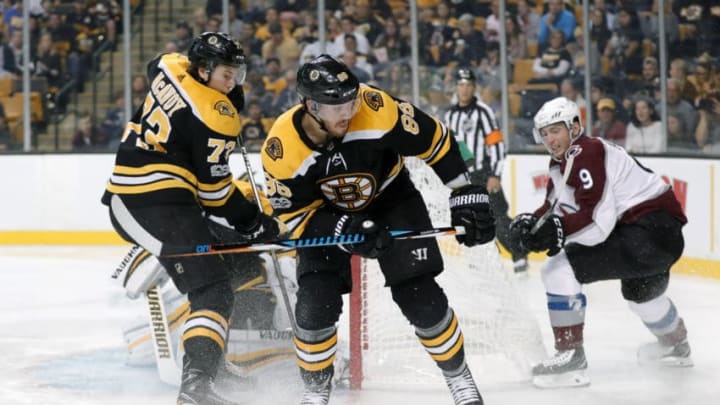The Boston Bruins have successfully survived the first of July, the first day of the NHL free agency period. How can the Bruins create the salary cap space even without unloading David Backes and his contract?
The Boston Bruins have still some pending restricted free agents, but they have to be very creative in order to manage to sign all their young players.
The Bruins are on the crossroads once again. Until September, they can do whatever they wish. But once the regular season is underway, the Bruins must fill under the salary cap hit of $81.5 million. How might it be possible for the Boston Bruins to create the salary cap space? And that doesn’t include trading David Backes’ contract, which would always help. A lot.
If the Bruins are willing to trade David Backes, they will have to repeat what the Toronto Maple Leafs have done with Patrick Marleau. Attaching a first-round draft pick, or a high-end prospect, preferably a former first-round draft choice.
More from Editorials
- Pavel Zacha’s veteran status leading to bigger role in 2023-24
- The Bruins should take a look at these four free agents
- Why the Bruins should wait to name a captain until after the season
- 3 players the Bruins can, 3 players could trade, 3 players they shouldn’t trade
- It’s time to offer Jake DeBrusk a contract extension
As it stands now, the only team having that plenty of the salary cap space left is the Ottawa Senators with more than $20 million. Would David Backes accept a trade there? It seems highly doubtful.
As it stands now, according to CapFriendly, the Bruins have $10,153,334 of their salary cap space left to use. Charlie McAvoy, Danton Heinen, and Brandon Carlo will require new deals. How much would it cost the Bruins?
McAvoy, we’re guessing to have a salary cap hit of approximately $7,000,000 per season. Brandon Carlo would take, let’s say, some sort of a $4,000,000 per campaign contract. Heinen would be up to $2,500,000. The Bruins can probably sign the bridge deals with each of these players and can lower the salary cap hit. But that doesn’t help the term issue.
Looking at the prices around the NHL, especially for the defensemen, if the Boston Bruins can lock up McAvoy for $7,000,000 for seven years, comparing this deal to recently signed deal worth $6,000,000 per season for Tyler Myers in Vancouver, or others, that wouldn’t be as bad for the B’s.
Those three deals would take $13.5 million. The Bruins have presently something over $10 million. The CapFriendly has made that calculation with the Bruins roster at 25 players. There can be just 23 men on the NHL roster – that means the Bruins can jump to approximately $12 million. Still a little below two million short.
For the first few weeks, John Moore will seemingly be on the long-term injured reserve after his shoulder surgery. But that’s not a long-term solution, of course. Moore should be back before December. As of now, the Bruins can create up to $4.5 million in the salary cap space, rather easily.
Kevan Miller will become a pending unrestricted free agent next summer. He will be 32. With the Boston Bruins possessing Carlo, McAvoy, recently re-signed Connor Clifton or Steven Kampfer on the right side of the defense, keeping Miller with the decision not to re-sign him next summer is almost suicidal financially. The Bruins will have to repeat the fate of Adam McQuaid from the past September.
Trading away Kevan Miller can just cover the Bruins needs to easily re-sign Heinen, Carlo, and McAvoy. Do the Bruins try to create more salary cap space afterward? That’s possible.
There have been some rumblings around that the Bruins might trade Joakim Nordstrom. Why? Simply because the Bruins have Sean Kuraly, Chris Wagner, Nordstrom. Par Lindholm and David Backes. Five players, who can only play as the fourth liners. There have been some experiments to try to move these guys higher in the lineup but… Nope. There can be another million saved.
Don’t trade David Backes or buy him out (wouldn’t save a penny, literally), if this is the scenario. You could consider sending him down to Providence in the AHL, the Bruins would save something over one million per season.
In other words, the Bruins will re-sign McAvoy, Carlo, and Heinen, no worries. One of the reasons, or maybe the only reason, why the Bruins didn’t go for something more moderate (to say at least) on the free agents’ market (maybe a guy like Micheal Ferland or Brian Boyle) and instead signed Brett Ritchie and Lindholm, was the uncertainty of how much the Bruins would have in the salary cap space after their RFA’s signings and the potential clearings and savings. Truly, the Bruins have to count every penny in order to make the next season work.
The Boston Bruins General Manager Don Sweeney is well aware of that. The Bruins will find a way how to make their three big youngsters re-signed. The question is, will they find a way how to further improve the roster without any big trade? If he’s creative, there might be a few windows open. But just a few, to make absolutely sure.
